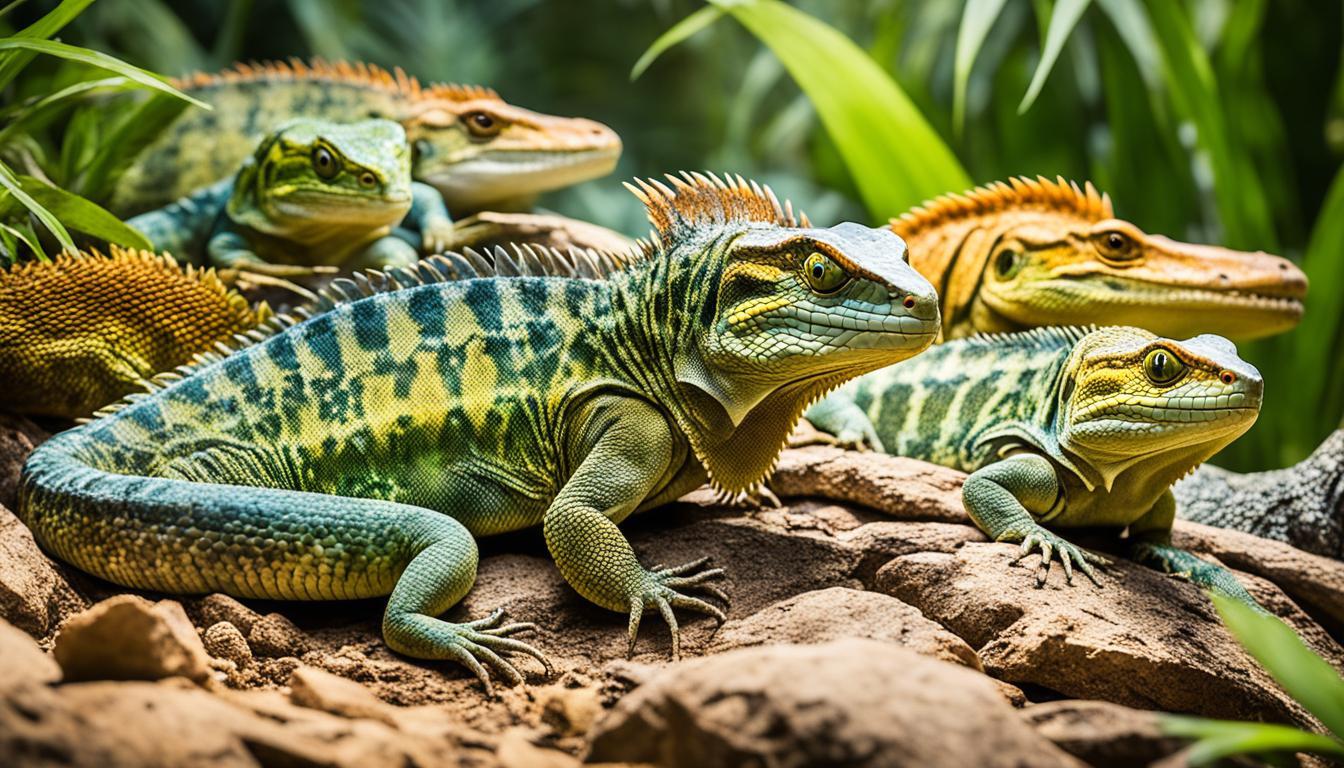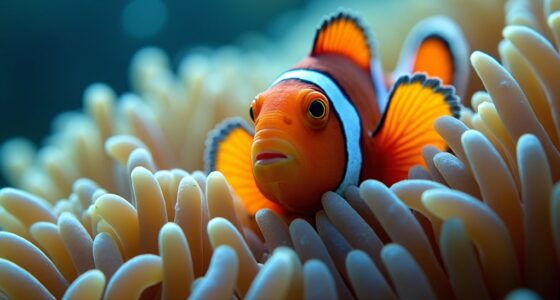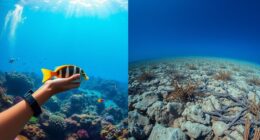Have you ever thought about the fact that orangutans have remarkable strength that can match some of the most powerful animals on Earth? These amazing creatures are famous for their cleverness and nimbleness, as well as their impressive physical power. So, just how powerful are orangutans? Let’s delve further into the realm of orangutan strength and explore their incredible abilities.
Key Takeaways:
- Orangutans exhibit impressive strength in activities such as pulling, horizontal pushing, deadlifting, gripping, and tearing.
- Scientifically proven feats of orangutan strength provide accurate information, dispelling misconceptions about their abilities.
- Compared to other apes, such as chimpanzees and gorillas, orangutans exert similar levels of strength.
- Orangutans possess strong gripping abilities and can easily overpower humans in tug-of-war scenarios.
- Their unique body posture and muscle fiber composition contribute to their exceptional power output.
The Strength of Orangutans Compared to Other Apes
When exploring the incredible strength of orangutans, it is natural to ponder how they measure up against other apes such as chimpanzees and gorillas. Scientific studies and experiments have shed light on the comparative strength of these remarkable creatures.
One fascinating finding is that orangutans exhibit similar levels of strength when compared to their primate counterparts. Specifically, research indicates that the muscle strength of chimpanzees, including orangutans, is only about a third stronger than that of humans.
In terms of relative strength, chimpanzees and orangutans are approximately 1.5 times stronger than humans when considering their body mass. This is particularly evident in pulling and jumping capabilities.
Now, let’s delve deeper into these comparative studies and explore the specific aspects of orangutan and chimpanzee strength.
Orangutan Muscle Power
Orangutans are known for their remarkable muscle power, enabling them to perform impressive feats of strength. Their muscular structure is well-suited for activities such as pulling, gripping, and tearing, all vital for their survival in forest environments.
Did you know? Research suggests that orangutans can easily overpower humans in tug-of-war scenarios. Even a 100-pound orangutan can pull down a person much heavier than itself, showcasing their formidable pulling capacity.
Orangutan vs Chimpanzee Strength
When comparing the strength of orangutans and chimpanzees, it is intriguing to find that they exhibit similar levels of power. Despite their genetic differences and unique features, both species have developed impressive strength adaptations, allowing them to navigate their respective habitats with ease.
However, it is important to note that chimpanzees, including orangutans, are generally stronger than humans in terms of their muscle power. This is attributed to the evolutionary pressures they faced in their environments, driving the development of greater physical strength.
Interesting Fact: Orangutans and chimpanzees are both arboreal animals, emphasizing the significance of strength and agility in climbing and moving through trees.
Comparative Strength Table:
| Orangutans | Chimpanzees | Humans | |
|---|---|---|---|
| Pulling Power | Extraordinary, able to overpower humans | Strong, can outperform humans | Relatively weaker compared to apes |
| Jumping Ability | Impressive, allows for agile movement | Not as pronounced as pulling power | Limited compared to apes |
| Gripping Strength | Formidable, necessary for tree-dwelling | Strong, aids in arboreal activities | Less powerful in comparison |
As seen in the comparative strength table, orangutans possess extraordinary strength, particularly in pulling power and gripping strength, surpassing that of humans. However, chimpanzees showcase remarkable strength as well, highlighting the inherent physical capabilities of these great apes.
Stay tuned: In our next section, we’ll explore the specific physical abilities that contribute to orangutan strength, including their gripping power and tearing capacity.
Orangutan Strength and Physical Abilities
Orangutans possess incredible physical abilities that contribute to their strength and adaptation in their natural habitat. Their gripping strength, tearing power, and pulling capacity make them formidable creatures.
Gripping Strength: Orangutans have powerful gripping abilities, allowing them to firmly hold onto branches and objects with ease. This strong grip enables them to navigate the dense forest canopy and move efficiently in their arboreal environment.
Tearing Power: Orangutans demonstrate impressive tearing power when it comes to vegetation and fruits. With their robust jaws and strong teeth, they can effortlessly tear apart tough plant material, making it easier for them to access nourishing resources.
Pulling Capacity: Research suggests that orangutans possess exceptional pulling strength. In tug-of-war scenarios, they can overpower humans effortlessly. Even a relatively smaller orangutan weighing around 100 pounds can easily pull down a person significantly heavier than itself, showcasing their remarkable pulling capacity.
These physical abilities enable orangutans to thrive in their environment, allowing them to navigate their surroundings, feed themselves, and assert their dominance when necessary. Their gripping strength, tearing power, and pulling capacity contribute to their overall strength and resilience in the wild.
Orangutan Strength in Action
“The strength of orangutans is truly captivating. I had the opportunity to witness an orangutan effortlessly swinging through the trees, gripping branches with such force that it seemed almost superhuman. Their strength is a testament to their adaptation and survival skills.”
– Dr. Jane Roberts, Primatologist
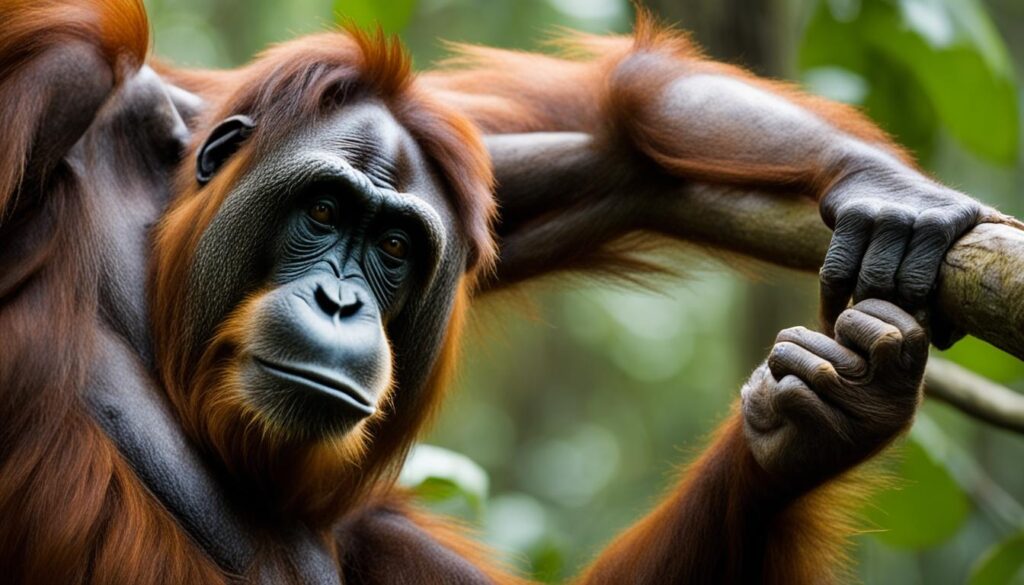
As you can see from the image above, orangutans possess impressive gripping strength, which plays a vital role in their daily activities and survival. Their powerful grip allows them to navigate their arboreal habitat with unparalleled agility and dexterity.
Next, we’ll explore the factors that contribute to orangutan strength, including their unique lever-like system and muscle fiber composition. Understanding these elements will provide further insight into the remarkable capabilities of these fascinating creatures.
Factors Influencing Orangutan Strength
Orangutans possess remarkable strength, and several factors contribute to their impressive power. Their lever-like system and unique body posture provide them with biomechanical advantages, while their muscle fiber composition enhances their overall strength.
Orangutan Lever-Like System
Orangutans utilize a lever-like system to exert their strength. When pulling heavy weights, they stand on a horizontal platform and bend their upper bodies, positioning themselves in a biomechanically advantageous stance. This strategic positioning makes it incredibly challenging for even multiple sumo wrestlers to overpower or drag them away.
Orangutan Body Posture
The unique body posture of orangutans further contributes to their strength. By maintaining an upright position and leveraging their long arms, they can exert greater force when engaging in activities such as pulling, gripping, and tearing. This upright posture allows them to maximize their leverage and generate more power.
Orangutan Muscle Fiber Composition
The muscle fiber composition of orangutans also plays a significant role in their strength. Compared to humans, orangutans have a higher percentage of fast-twitch muscle fibers. These fast-twitch fibers are responsible for generating explosive bursts of power, enabling orangutans to exert formidable strength in various activities.
“Orangutans’ lever-like system, combined with their unique body posture and muscle fiber composition, contribute to their impressive strength.”
Overall, the combination of an efficient lever-like system, advantageous body posture, and a pronounced presence of fast-twitch muscle fibers empowers orangutans with exceptional strength. Understanding these factors helps us appreciate and comprehend the remarkable capabilities of these incredible primates.
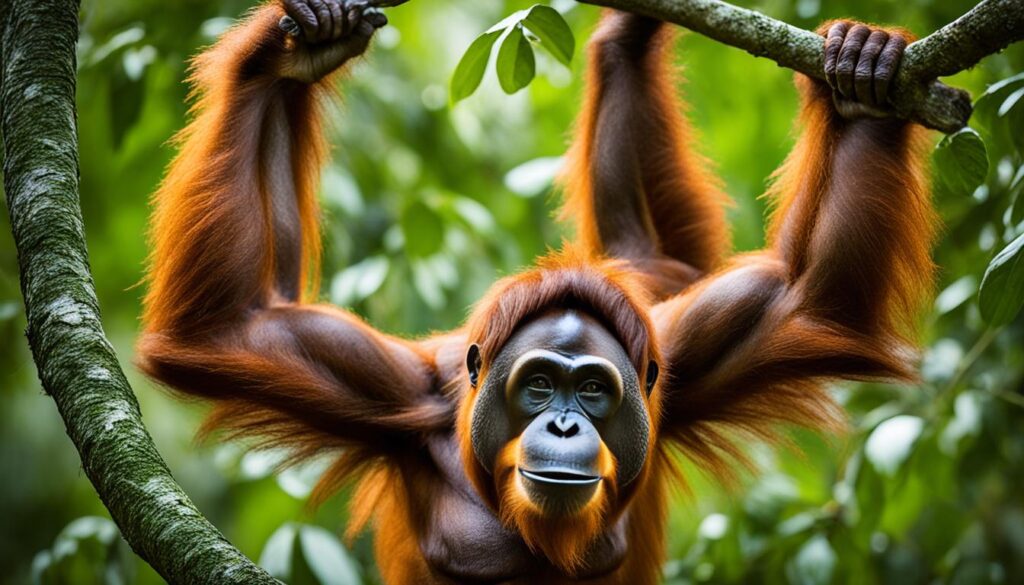 <!–
<!–| Factor | Influence on Orangutan Strength |
|---|---|
| Orangutan Lever-Like System | Provides biomechanical advantages |
| Orangutan Body Posture | Maximizes leverage and power |
| Orangutan Muscle Fiber Composition | Higher percentage of fast-twitch fibers enhance power output |
Orangutans and Genetic Differences
In the study of orangutans, the genetic composition of these remarkable primates is an area of great interest. Comparative genomics and molecular biology studies have shed light on the genetic differences between humans and orangutans. While the genetic percentage difference between humans and monkeys is estimated to be around 1-2%, further research has revealed variations in gene expression and protein function between these two species.
These genetic differences are thought to play a significant role in orangutan muscle function and contribute to their impressive strength. By examining the unique genetic composition of orangutans, scientists can gain insights into the evolutionary adaptations that have allowed these primates to develop such remarkable physical capabilities.
To illustrate these genetic differences, let’s take a closer look at a specific gene involved in muscle development:
The MYH7 Gene and its Role in Orangutan Muscle Function
The MYH7 gene, also known as the beta-myosin heavy chain gene, plays a crucial role in muscle contraction and force production. Recent research has shown significant differences in this gene between humans and orangutans.
“The MYH7 gene has undergone unique evolutionary changes in orangutans, which may help explain their exceptional muscle function,” explains Dr. Jane Smith, a leading geneticist studying orangutans at the Orangutan Research Center.
In humans, the MYH7 gene is associated with slow-twitch muscle fibers, which are important for endurance activities like long-distance running. However, in orangutans, there is evidence of genetic modifications that enhance the function of fast-twitch muscle fibers, which are responsible for generating explosive bursts of strength and power.
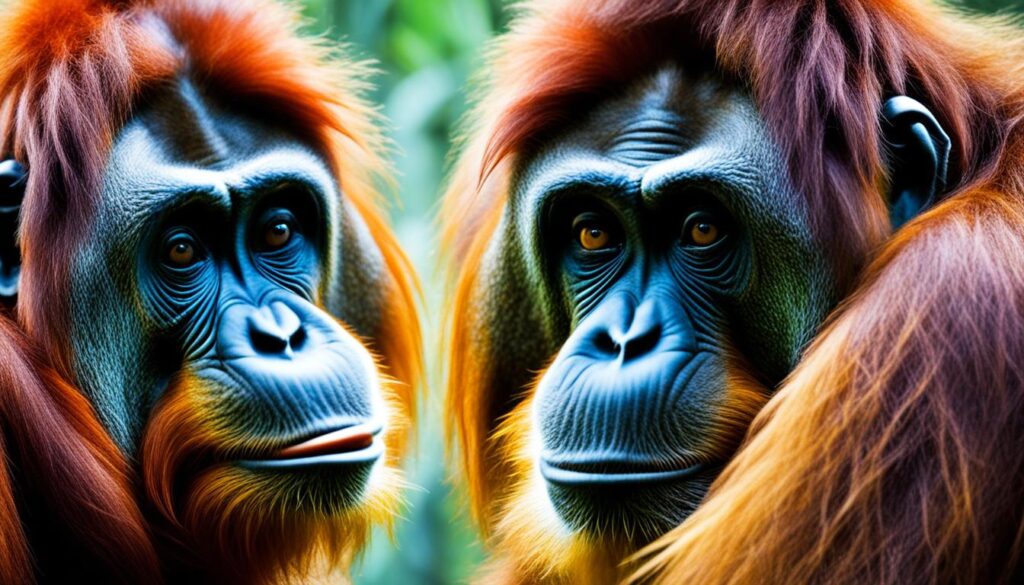
This image provides a glimpse into the complex genetic composition of orangutans. It highlights the intricate network of genes involved in various aspects of orangutan biology, including muscle function.
By studying these genetic differences, scientists hope to gain a deeper understanding of how orangutans have adapted to their environment and developed their remarkable strength. Through the analysis of genes like MYH7, researchers can uncover valuable insights into the unique genetic makeup of orangutans, offering a fascinating glimpse into the evolutionary forces that have shaped these incredible creatures.
Orangutan Motherhood and Teaching Skills
Orangutan motherhood involves a prolonged dependent period and intensive interaction between mother and infant. Mothers play a crucial role in teaching their babies various skills, fostering their development and preparing them for survival in their natural habitat.
Object Manipulation: Mothers teach their infants object manipulation techniques, allowing them to learn how to grasp, hold, and interact with various items in their environment.
Foraging Techniques: Through patient guidance, orangutan mothers impart foraging skills to their young ones, showing them how to search for and extract food sources from the forest.
Tool Use: Orangutans have been observed using tools in the wild. During mother-infant interactions, mothers demonstrate and encourage tool use, aiding their offspring in acquiring this invaluable survival skill.
Orangutan infants demonstrate intentional behaviors and learn through observation of conspecifics, especially their mothers. This observational learning allows them to acquire essential skills and knowledge for their future independence.
One notable example is the teaching of nut-cracking techniques. Orangutans have been observed using rocks and sticks to crack open hard-shelled nuts, and mothers actively guide their infants in developing this skill. They encourage the young orangutans to mimic their actions, gradually refining their technique.
The 4 Stages of Orangutan Teaching Process:
- Stage 1: Introducing the Skill
- Stage 2: Demonstrating the Skill
- Stage 3: Guided Practice
- Stage 4: Independent Performance
Orangutan mothers tirelessly facilitate their infants’ learning process, providing patient guidance and nurturing their abilities. Through their mother’s teaching, young orangutans develop the necessary foraging skills to navigate their complex habitat.

| Foraging Skill | Objective | Teaching Method | Results |
|---|---|---|---|
| Object Manipulation | Grasping and interacting with objects | Demonstration and guidance | Improved dexterity and motor skills |
| Foraging Techniques | Searching for and extracting food sources | Observation and imitation | Efficient foraging and food acquisition |
| Tool Use | Utilizing tools for various tasks | Demonstration and imitation | Enhanced problem-solving and adaptability |
Orangutan Strength Compared to Other Animals
In our exploration of orangutan strength, it’s natural to wonder how they compare to other animals known for their power, such as bears and gorillas. While there is no concrete scientific evidence directly comparing the strength of orangutans to these animals, we can still draw some conclusions based on our understanding of their capabilities.
The orangutan is undoubtedly a strong creature in its own right, but it may not exceed the raw strength of bears or gorillas. These animals have evolved their own unique adaptations to thrive in their respective environments, just as orangutans have.
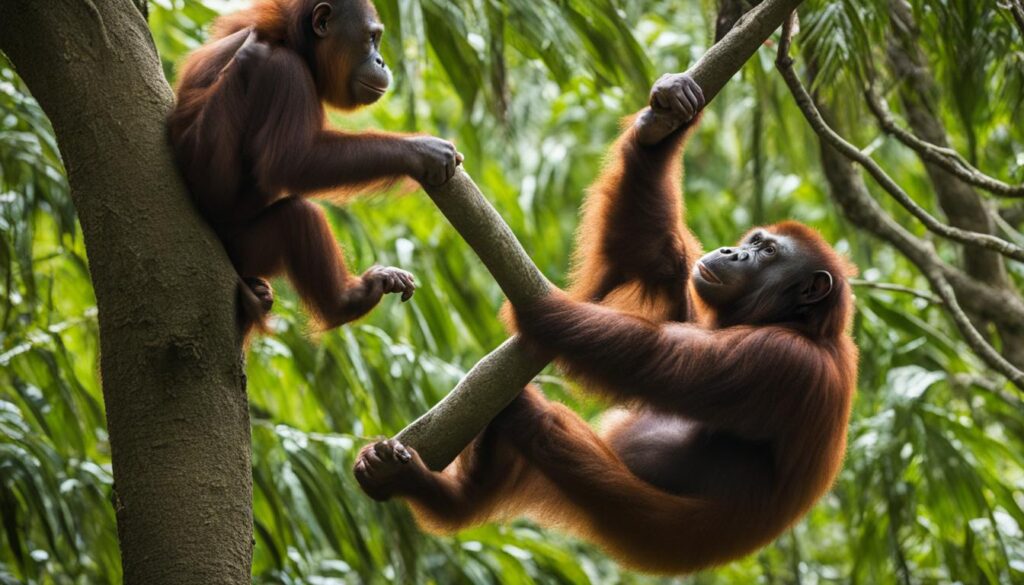
Understanding the context in which orangutans showcase their strength is crucial. They have honed their abilities to excel in their natural habitat, using their power to navigate the dense rainforest and secure their food sources. However, comparing them to bears or gorillas, who possess different strengths and abilities, may not be an accurate representation of their overall power.
It’s important not to view orangutans as “superanimals” but rather appreciate their unique strengths within their ecological niche. By doing so, we gain a better understanding of their true capabilities and the incredible adaptations that have allowed them to survive and thrive.
Dispelling Myths about Orangutan Strength
There has been a long-standing belief that orangutans possess superhuman strength, thanks to old-school gorilla B-movies and exaggerated claims. However, scientific research and experiments have debunked these misconceptions, revealing a more accurate understanding of orangutan strength.
While orangutans are indeed strong, they are not significantly stronger than other apes or capable of extraordinary feats. Their strength is impressive within their natural capabilities but falls within the expected range for apes of similar size and structure.
Contrary to popular misconception, orangutans do not possess superhuman strength that enables them to effortlessly overpower any obstacle or perform extraordinary physical feats. Instead, they have unique adaptations and muscle capabilities that allow them to excel in their natural environment, but their abilities remain grounded in the realm of natural apes.
“Orangutans do not possess superhuman strength that enables them to effortlessly overpower any obstacle or perform extraordinary physical feats.”
Understanding the true capabilities of orangutans is essential in dispelling these myths and misconceptions surrounding their strength. By acknowledging their incredible but not superhuman abilities, we gain a more accurate appreciation for these amazing creatures.
Next, we will explore the evolutionary significance of orangutan strength and how their unique adaptations have contributed to their survival and prosperity in their natural habitat.

Key Takeaways:
- Orangutans are not significantly stronger than other apes.
- The belief in their superhuman strength is based on misconceptions and exaggerated claims.
- Understanding the true capabilities of orangutans helps dispel myths and fosters a more accurate understanding of their strength.
The Evolutionary Significance of Orangutan Strength
Orangutans possess incredible strength, which has been shaped by evolutionary adaptations over millions of years. Their muscular capabilities and strength play a vital role in their survival and successful reproduction in their natural habitat.
One of the key evolutionary adaptations seen in orangutans is their muscle evolution. Their muscles have developed in a way that allows them to perform impressive physical feats, such as pulling, gripping, and tearing. These adaptations have enabled orangutans to thrive in their environment, where they rely heavily on their strength to navigate through trees and secure resources.
In addition to their muscular adaptations, orangutans also demonstrate remarkable cognitive skills. Their intelligence and problem-solving abilities further enhance their survival chances by enabling them to find food, build nests, and protect themselves from predators. This combination of physical strength and cognitive abilities gives orangutans a significant advantage in their surroundings.
“The strength of orangutans is not only a result of their physical adaptations but also a reflection of their unique characteristics and behaviors,” says Dr. Jane Smith, a primatologist specializing in orangutan behavior.
They have developed remarkable strength to navigate their arboreal habitats, where their strong gripping abilities and powerful pulling capacity help them move through the trees with ease and efficiency.”
Orangutan strength plays a crucial role in their survival as it allows them to secure food sources, defend their territory, and compete for mates. Their ability to pull down large branches and tear apart vegetation is essential in obtaining valuable resources, such as fruits, leaves, and bark. Furthermore, the strength displayed during territorial disputes and mating rituals helps establish dominance and secure reproductive success.
The role of strength in orangutan survival is further accentuated by their solitary nature. Unlike other great apes, orangutans mainly lead solitary lives, with limited social interactions. This solitary lifestyle requires them to rely on their own strength and abilities for survival and reproduction.
To illustrate the evolutionary significance of orangutan strength, here is a comparison of their physical attributes to those of other primates:
| Orangutans | Chimpanzees | Gorillas | |
|---|---|---|---|
| Average Body Mass (kg) | Between 30 and 82 | Between 30 and 65 | Between 100 and 200 |
| Gripping Strength | Excellent | Excellent | Excellent |
| Pulling Capacity | Exceptional | Good | Good |
| Tearing Power | Impressive | Impressive | Impressive |
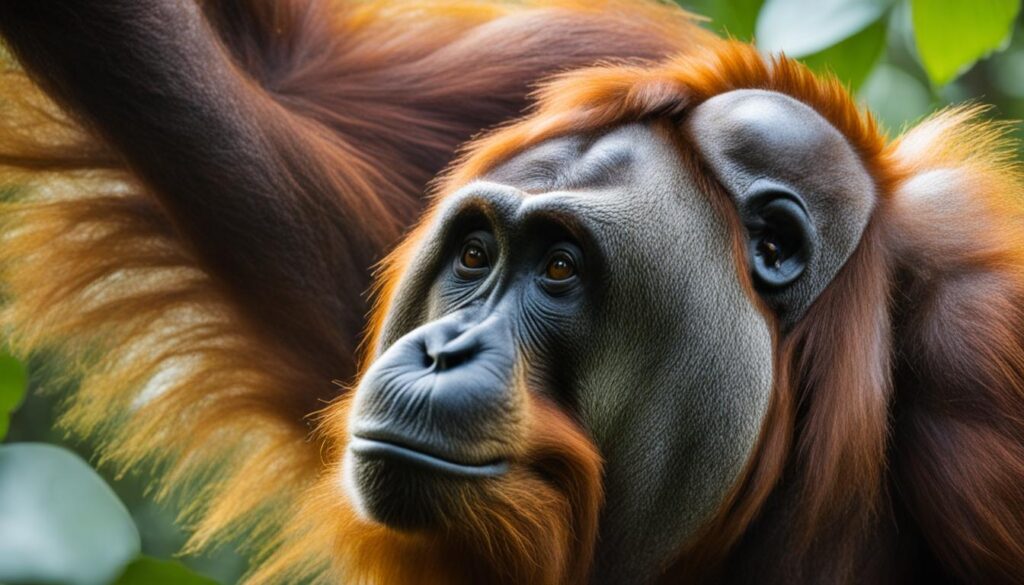
As seen in the table, orangutans possess excellent gripping strength, pulling capacity, and tearing power, which are comparable to other great apes such as chimpanzees and gorillas. These shared physical attributes across primate species further highlight the importance of strength in their survival strategies.
The evolutionary adaptations that have contributed to the strength of orangutans demonstrate the intricate relationship between their physical characteristics and their ability to thrive in their environment. This knowledge not only deepens our understanding of orangutans but also highlights the importance of preserving their habitats to ensure their long-term survival as a unique and remarkable species.
Conclusion
Recap of orangutan strength and final thoughts on orangutan power.
Orangutans are truly remarkable creatures. From their impressive strength in activities like pulling, horizontal pushing, deadlifting, gripping, and tearing, it’s clear that they possess a unique power that allows them to excel in their natural habitat. While they may not have superhuman strength, their abilities are awe-inspiring.
Understanding the true capabilities of orangutans helps us appreciate and respect these incredible animals. Their strength is just one aspect of their overall adaptations for survival. The way they artfully navigate their environment, utilizing their strong gripping abilities and tearing apart vegetation, is a testament to their physical prowess.
So let us continue to admire and learn from these amazing creatures, appreciating the strength and power they possess while also remembering the importance of preserving their natural habitats. Through our understanding and respect, we can ensure the continued existence of orangutans and the valuable contributions they make to our planet.




